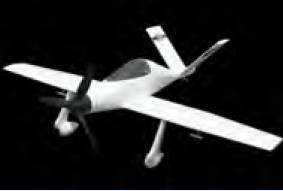Society News
A crunch point for hydrocarbon-powered light aviation?
As more and more electric light aircraft are announced, are we in the twilight of new designs for hydrocarbon-powered GA? CHRIS WRIGHT of the RAeS General Aviation Group (GAG) looks ahead to this month’s Light Aircraft Design Conference to preview what the 21st Century holds for light aviation.
The general aviation sector is well-positioned to demonstrate new technologies: radical power systems, electronic technology applied to control and navigation, optimised structures and materials plus the latest aerodynamics.
 Rolls-Royce’s ACCEL’s Spirit of Innovation on its first flight in September – an E-Condition Project, as presented in previous Design Conferences. Rolls-Royce.
Rolls-Royce’s ACCEL’s Spirit of Innovation on its first flight in September – an E-Condition Project, as presented in previous Design Conferences. Rolls-Royce.
GAG holds a Light Aircraft Design Conference and a Light Aircraft Design Competition each year. The GAG aims to encourage individuals and industry to address current concerns and opportunities by imaginative application of what is possible.
In the past three years the Design Conference has attempted to encompass the wide scope of GA. This year the programme is arranged in three sessions and, because it is web-based, we have been able to add more items and, therefore, widen its spread of topics.
The first session (of three) includes aircraft-related. The first talk is by Norman Wijker of Samad Aerospace, who has previously described the Samad Starling VTOL vehicle. Norman has been involved with Sailwings for high-performance yachts and sailboats and will talk about those which employ highly-developed aerodynamics and structures in their sails. Hania Mohiuddin, the current chair of the British Human Powered Flying Club, will be describing her design for a flying-wing human-powered aircraft (HPA). HPAs also have sophisticated aerodynamics and structures relevant to future light aircraft design. A Flylight team led by Paul Dewhurst will describe developing the already-successful Skyranger Microlight into the Nynja version with improved structure and aesthetics.
Dr Guy Gratton with his Cranfield team will discuss EnablE which includes work on electrically powering two microlights and certification aspects.
GAG initiated and worked with the CAA to produce Experimental Conditions. The object of E-Conditions is to benefit light aircraft designers and manufacturers by reducing the red tape and financial burdens associated with securing airworthiness and approval for new aircraft designs, encouraging the growth of new design concepts. A number of projects have been pursued under E-Conditions, including the recently flown ACCEL Spirit of Innovation. John Edgley was the driving force behind E-Conditions and his update will start session two.
GAG has also been working on a ‘Design/Make/Fly’ initiative which Dr Mike Jump (Liverpool University) has been steering and will describe. It is hoped that this, combined with our annual GA Design Competition, and aided by E-Conditions, will encourage fresh design and development impetus in universities and associated manufacturing groups, along the lines of the long-running and successful German Akafliegs.
 To round off the conference in a most exciting way, Marc Umbright from Pie Aeronefs will give a talk on its new Air Race E UR-1 racing aircraft. Aeronefs.In conjunction with the Design Conferences the recent annual Design Competitions, run in parallel with the conferences, have also had an electric theme. The competitions are based not only on design and performance but also the quality of the supporting documentation.
To round off the conference in a most exciting way, Marc Umbright from Pie Aeronefs will give a talk on its new Air Race E UR-1 racing aircraft. Aeronefs.In conjunction with the Design Conferences the recent annual Design Competitions, run in parallel with the conferences, have also had an electric theme. The competitions are based not only on design and performance but also the quality of the supporting documentation.
In 2020 the Design Competition specified Electric Powered Humanitarian Rescue VTOL aircraft suitable for evacuating casualties between islands in the Caribbean. Some elegant designs resulted, the winner being the high-aspect-ratio APTOS BLUE being capable of flying up to 463km.
Tim Watkins (from ETPS) will describe the Design Competition which this year has been brought in line with the academic year. As a result, the competition runs through this year and next, with the results being announced in time for presentation at next year’s Design Conference. The competition is once again an aid-related design competition, for a relatively simple design that many designers and students are likely to feel able to tackle. It brings together two key changes in aeronautics – the popular new 600kg category and electric power. The aim is to design a piloted electric aircraft that will deliver a passenger or essential supplies in equatorial countries from short soil airstrips.
Session two is rounded off by Brian Stirm and Bernie Wulle, both of Purdue University presenting: ABLE Flight, Adapting Light Aircraft for the Disabled.
Session three returns to the electrification theme and looks at the influence and pressures due to Climate Change. This session will look at maximising range with electric and hybrid hydrogen solutions from Sergey Kiselev of Zeroavia. A panel discussion on this vital topic – for the continuation of GA flight – will complete this session.